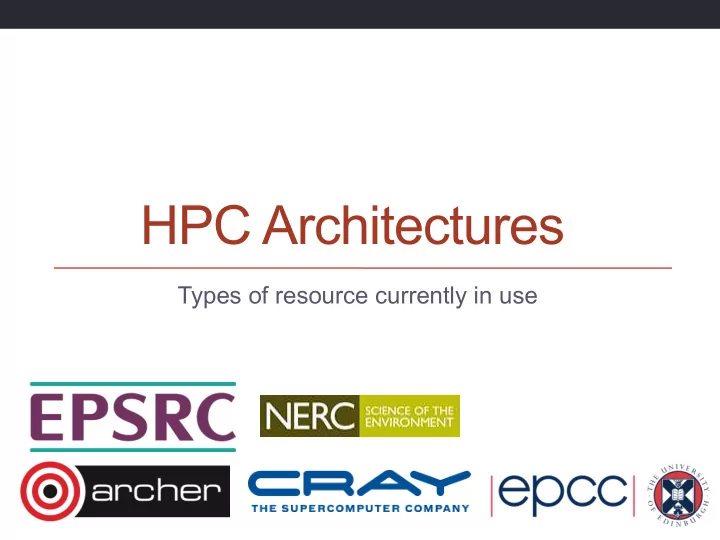

HPC Architectures Types of resource currently in use
Outline • Shared memory architectures • Distributed memory architectures • Distributed memory with shared-memory nodes • Accelerators • What is the difference between different Tiers? • Interconnect • Software • Job-size bias (capability)
Shared memory architectures Simplest to use, hardest to build
Symmetric Multi-Processing Architectures • All cores have the same access to memory
Non-Uniform Memory Access Architectures • Cores have faster/wider access to local memory
Shared-memory architectures • Most computers are now shared memory machines due to multicore • Some true SMP architectures … • e.g. BlueGene/Q nodes • … but most are NUMA • Program NUMA as if they are SMP – details are hidden from the user. • Difficult to build shared-memory systems with large core numbers (> 1024 cores) • Expensive and power hungry • Some systems manage by using software to provide shared- memory capability
Distributed memory architectures Clusters and interconnects
Distributed-Memory Architectures
Distributed-memory architectures • Each self-contained part is called a node . • Almost all HPC machines are distributed memory in some way • Although they all tend to be shared-memory within a node. • The performance of parallel programs often depends on the interconnect performance • Although once it is of a certain (high) quality, applications usually reveal themselves to be CPU, memory or IO bound • Low quality interconnects (e.g. 10Mb/s – 1Gb/s Ethernet) do not usually provide the performance required • Specialist interconnects are required to produce the largest supercomputers. e.g. Cray Aries, IBM BlueGene/Q • Infiniband is dominant on smaller systems.
Distributed/shared memory hybrids Almost everything now falls into this class
Hybrid Architectures
Hybrid architectures • Almost all HPC machines fall in this class • Most applications use a message-passing (MPI) model for programming • Usually use a single process per core • Increased use of hybrid message-passing + shared memory (MPI+OpenMP) programming • Usually use 1 or more processes per NUMA region and then the appropriate number of shared-memory threads to occupy all the cores • Placement of processes and threads can become complicated on these machines
Example: ARCHER • ARCHER has two 12-way multicore processors per node • Each 12-way processor is made up of two 6-core dies • Each node is a 24-core, shared-memory, NUMA machine
Accelerators How are they incorporated?
Including accelerators • Accelerators are usually incorporated into HPC machines using the hybrid architecture model • A number of accelerators per node • Nodes connected using interconnects • Communication from accelerator to accelerator depends on the hardware: • NVIDIA GPU support direct communication • AMD GPU have to communicate via CPU memory • Intel Xeon Phi communication via CPU memory • Communicating via CPU memory involves lots of extra copy operations and is usually very slow
Comparison of types What is the difference between different tiers?
HPC Facility Tiers • HPC facilities are often spoken about as belonging to Tiers Tier ¡0 ¡– ¡Pan-‑na,onal ¡Facili,es ¡ Tier ¡1 ¡– ¡Na,onal ¡Facili,es ¡ Tier ¡2 ¡– ¡Regional ¡Facili,es ¡ Tier ¡3 ¡– ¡Ins,tu,onal ¡Facili,es ¡
Summary • Vast majority of HPC machines are shared-memory nodes linked by an interconnect. • Hybrid HPC architectures – combination of shared and distributed memory • Most are programmed using a pure MPI model (more later on MPI). • Does not really reflect the hardware layout • Shared HPC machines span a wide range of sizes: • From Tier 0 – Multi-petaflops (1 million cores) • To workstations with multiple CPUs (+ Accelerators)
Recommend
More recommend